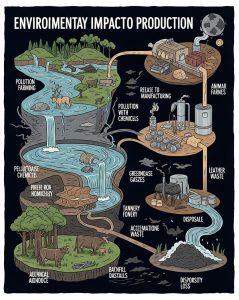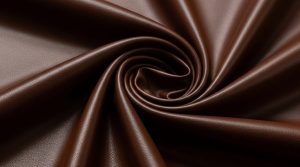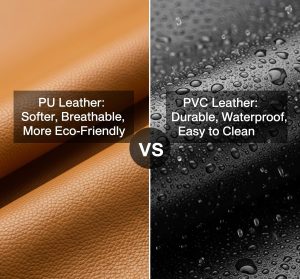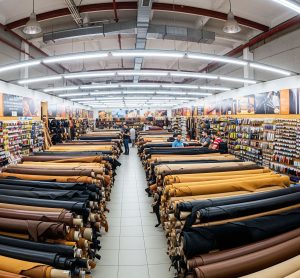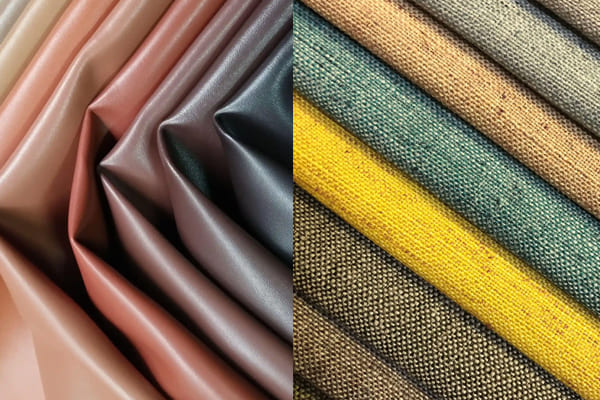
Lorsqu'il s'agit du grand débat entre le cuir et le tissu, c'est comme choisir entre un concert de rock classique et une séance de musique acoustique. Le cuir, avec son côté audacieux, se présente comme une rock star prête à occuper le devant de la scène - pensez aux vestes luxueuses et aux sacs à main élégants qui vieillissent comme du bon vin. Quant au tissu, son acolyte polyvalent, il offre confort et élégance, prêt à tout, d'un brunch décontracté à une aventure sauvage. Mais avant de vous laisser séduire par le glamour du cuir ou l'étreinte douillette du tissu, nous allons nous pencher sur les détails : confort, durabilité, esthétique et même les tâches d'entretien fastidieuses. Alors, prenez votre pop-corn (ou une veste en cuir), nous allons décortiquer ce face-à-face stylé et déterminer une fois pour toutes si le cuir est vraiment meilleur que le tissu ou s'il s'agit simplement d'une question de goût personnel.
L'énigme du confort : cuir et tissu au quotidien
En matière de confort, le choix entre le cuir et le tissu se résume souvent à des préférences personnelles et au contexte spécifique d'utilisation. Le cuir, bien que luxueux et élégant, peut parfois sembler rigide ou chaud, en particulier dans les climats chauds ou lors d'un port prolongé. Toutefois, avec le temps, le cuir de haute qualité devient souvent plus souple et se moule au corps, créant ainsi un ajustement personnalisé. Le tissu, quant à lui, est généralement plus léger et plus respirant, ce qui en fait un choix de prédilection pour les tenues décontractées et les saisons chaudes. Le coton, le lin et les mélanges offrent un toucher doux sur la peau et sont souvent dotés de propriétés d'évacuation de l'humidité, ce qui est idéal pour les modes de vie actifs. En fin de compte, le confort est subjectif ; ce qui semble confortable à une personne peut sembler contraignant à une autre. Tenez compte de votre mode de vie, du climat et de l'usage que vous comptez faire de l'article lorsque vous choisissez entre ces deux matières.
Concours de durabilité : Quel matériau dure le plus longtemps ?
La durabilité est un facteur essentiel dans le débat entre le cuir et le tissu. Le cuir est réputé pour sa longévité ; lorsqu'il est correctement entretenu, il peut durer des décennies, développant une belle patine qui rehausse son caractère au fil du temps. Il résiste aux déchirures et à l'abrasion, ce qui en fait un matériau idéal pour les articles à usage intensif tels que les vestes et les meubles. En revanche, la durabilité du tissu peut varier considérablement en fonction du type de tissu utilisé. Alors que certains tissus synthétiques sont conçus pour une utilisation intensive, les fibres naturelles comme le coton peuvent montrer des signes d'usure et de déchirure plus rapidement. Dans les environnements exposés aux éclaboussures ou à un usage intensif, le cuir est généralement le plus résistant. Toutefois, les tissus de haute qualité, en particulier ceux qui sont traités pour durer, peuvent également tenir leur rang. L'essentiel est de prendre en compte les articles spécifiques et l'usage auquel ils sont destinés. Bien que le cuir puisse durer plus longtemps dans l'ensemble, le bon tissu peut offrir une résistance impressionnante dans les bonnes conditions.
L'attrait esthétique : Points de style pour le cuir et le tissu
L'esthétique joue un rôle important dans le débat entre le cuir et le tissu, car les deux matériaux offrent des qualités visuelles et tactiles uniques. Le cuir dégage une impression de sophistication et d'intemporalité, souvent associée aux marques de luxe et aux articles de haute couture. Ses riches textures et ses variations naturelles rendent chaque pièce unique, ce qui plaît à ceux qui apprécient le savoir-faire artisanal. À l'inverse, le tissu peut offrir une palette plus large de couleurs, de motifs et de styles, ce qui permet une plus grande créativité en matière de design. Du plus décontracté au plus habillé, le tissu peut s'adapter à différentes tendances, ce qui le rend polyvalent dans le domaine de la mode. En fin de compte, le choix entre le cuir et le tissu peut refléter un style personnel : ceux qui préfèrent l'élégance classique peuvent se tourner vers le cuir, tandis que ceux qui aiment les motifs éclatants peuvent se tourner vers le tissu. La décision dépend souvent de l'aspect spécifique que vous recherchez et de l'impression que vous voulez donner.
L'entretien, c'est important : Le facteur d'entretien du cuir et du tissu
En matière d'entretien, le cuir et le tissu ont des exigences différentes qui peuvent influencer votre choix. Le cuir est souvent perçu comme nécessitant beaucoup d'entretien, car il faut le conditionner régulièrement pour qu'il reste souple et ne se fissure pas. Il peut également être vulnérable à l'eau et aux taches, ce qui nécessite des produits de nettoyage spécialisés. Cependant, lorsqu'il est correctement entretenu, le cuir peut développer une belle patine qui lui confère du caractère au fil du temps. En revanche, le tissu est généralement plus facile à nettoyer ; de nombreux tissus peuvent être lavés en machine ou nettoyés par points sans traitement spécial. Toutefois, certains tissus peuvent se décolorer ou s'abîmer avec le temps, surtout s'ils sont exposés à la lumière du soleil ou à un usage intensif. En fin de compte, votre choix peut dépendre de l'effort que vous êtes prêt à consacrer à l'entretien par rapport à la longévité et aux avantages esthétiques que le cuir peut offrir.
Considérations sur les coûts : Valeur à long terme du cuir par rapport au tissu
Lorsque vous évaluez le coût du cuir par rapport à celui du tissu, il est essentiel de regarder au-delà du prix initial et de prendre en compte la valeur à long terme. Le cuir a tendance à être plus cher au départ, ce qui reflète sa durabilité et sa qualité. Bien qu'il nécessite un investissement initial plus important, le cuir de haute qualité peut durer des décennies s'il est bien entretenu, ce qui s'avère souvent plus économique à long terme. En revanche, les articles en tissu peuvent être plus abordables mais ne pas avoir la même durée de vie, en particulier s'ils sont fabriqués à partir de matériaux de moindre qualité. Les remplacements fréquents dus à l'usure peuvent s'accumuler au fil du temps, ce qui peut rendre le tissu moins rentable. Par conséquent, si vous comparez les coûts initiaux à la durabilité et à la longévité du cuir, vous aurez une idée précise de l'option qui pourrait constituer le meilleur investissement pour vos besoins.
Durabilité et éthique : Faire des choix éclairés
La durabilité et les considérations éthiques prennent de plus en plus d'importance dans le débat entre le cuir et le tissu. La production de cuir fait souvent l'objet d'un examen minutieux en raison des préoccupations relatives au bien-être des animaux et à l'impact environnemental de l'élevage. Toutefois, on peut également affirmer que le cuir est un sous-produit de l'industrie de la viande, contribuant ainsi à une économie circulaire. D'autre part, les tissus synthétiques, bien que souvent perçus comme plus éthiques, peuvent avoir des impacts environnementaux significatifs en raison des combustibles fossiles utilisés pour leur production et de la pollution générée lors de la fabrication. En outre, les matières synthétiques peuvent contribuer à la pollution microplastique lorsqu'elles sont lavées. Les consommateurs étant de plus en plus conscients de leurs choix, il est essentiel de rechercher et de comprendre les pratiques d'approvisionnement et de production du cuir et du tissu. En optant pour du cuir produit de manière éthique ou des tissus durables, vous pouvez prendre des décisions éclairées qui correspondent à vos valeurs, en veillant à ce que vos achats reflètent un engagement en faveur de la qualité et de la durabilité.
Conclusion
En fin de compte, le choix entre le cuir et le tissu est moins une question de vainqueur que de style personnel et de praticité. Le cuir offre une élégance et une durabilité intemporelles, ce qui en fait un investissement digne d'intérêt pour ceux qui apprécient son caractère riche et sa longévité. Le tissu, quant à lui, offre polyvalence et confort, ce qui est parfait pour ceux qui aiment expérimenter les couleurs et les motifs. En fin de compte, les deux matériaux ont leurs mérites et répondent à des styles de vie et des préférences différents. Que vous préfériez le luxe du cuir ou la familiarité du tissu, le meilleur choix est celui qui correspond à vos valeurs, à vos besoins et, bien sûr, à votre personnalité. Alors, adoptez la matière de votre choix et portez-la avec confiance - après tout, le style, c'est avant tout l'expression de ce que vous êtes !



